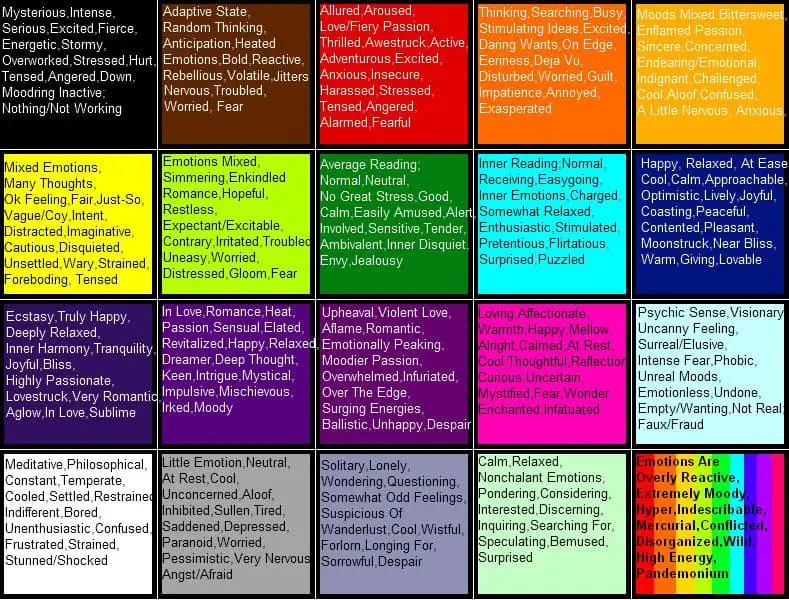The enigmatic allure of mood jewelry, particularly mood necklaces, lies in their capacity to reflect the wearer’s perceived emotional state through a chromatic spectrum. Understanding the color gradations, therefore, becomes paramount to interpreting the necklace’s pronouncements. Let’s delve into the meaning of the often-sought-after blue hue.
The Core Meaning of Blue: Tranquility and Composure
Generally, blue on a mood necklace signifies a state of calmness, relaxation, and overall emotional equilibrium. Consider it a barometer of serenity. It suggests that the wearer is experiencing a reduction in stress levels and an elevation in their sense of well-being. This isn’t merely a superficial interpretation; it reflects a physiological response correlated with emotional states.
Deconstructing the Blue Spectrum: Nuances in Shade
The specific shade of blue provides further granularity in understanding the emotional nuance:
- Light Blue: Often indicative of contentment, light blue represents a sense of ease and peacefulness. The wearer is likely feeling optimistic and untroubled. This shade suggests a mind free from significant anxieties.
- Medium Blue: This shade signals general relaxation. The wearer is neither overtly ecstatic nor noticeably stressed. A sense of balance pervades. This could indicate a state of reflective contemplation, a quiet afternoon, or simply a lack of intense emotional stimuli.
- Dark Blue: Moving towards the deeper end of the spectrum, dark blue may suggest deeper reflection or contemplation. While still within the realm of positive emotions, it hints at a slightly more introspective mood. The wearer may be engaged in thoughtful consideration of a particular issue or situation.
Physiological Underpinnings: How Body Temperature Plays a Role
Mood jewelry relies on thermochromic liquid crystals. These crystals alter their molecular structure in response to temperature fluctuations. These changes, in turn, affect the wavelengths of light they absorb and reflect, resulting in the color shifts we observe. Stress, relaxation, and other emotional states influence skin temperature through the autonomic nervous system. Vasoconstriction, the narrowing of blood vessels, can decrease skin temperature, while vasodilation, the widening of blood vessels, can increase it.
Therefore, when someone is relaxed and calm, their peripheral blood vessels tend to dilate slightly, leading to a minor increase in skin temperature. This incremental warming triggers the liquid crystals to shift towards the blue end of the spectrum.
Beyond the Binary: Context is Crucial
It’s essential to consider the context surrounding the mood necklace’s color display. A sudden shift from black (representing stress or tension) to blue indicates a significant relaxation response. Conversely, a consistent display of blue might represent a baseline state of tranquility for that individual.
External factors, such as ambient temperature, can also influence the necklace’s color. Cold environments can cause the necklace to display darker colors, potentially misrepresenting the wearer’s emotional state. Furthermore, individual physiology varies; some people naturally have warmer or cooler skin temperatures, impacting the baseline color displayed.
The Psychological Impact: A Self-Awareness Tool
Beyond its aesthetic appeal, a mood necklace can serve as a valuable tool for self-awareness. By observing the necklace’s color fluctuations throughout the day, individuals can gain insights into their emotional patterns and identify triggers that induce stress or promote relaxation. This heightened self-awareness can empower individuals to implement coping mechanisms and cultivate emotional regulation skills.
For instance, if the necklace consistently shifts towards darker colors during specific work-related tasks, the wearer might identify those tasks as stressors and seek strategies to mitigate their impact. Conversely, observing a consistent blue hue during leisure activities reinforces the importance of incorporating those activities into their routine.
Troubleshooting: Addressing Common Issues
Occasionally, mood necklaces may exhibit inaccuracies or inconsistencies. If the necklace consistently displays a single color regardless of emotional state, it may indicate a malfunction or degradation of the thermochromic crystals. Extreme temperatures can also damage the crystals, rendering the necklace unresponsive. Proper storage, away from direct sunlight and extreme heat or cold, is crucial for maintaining the necklace’s functionality.
If the necklace displays erratic or nonsensical color changes, it may be due to fluctuations in ambient temperature or moisture exposure. Ensure the necklace is kept dry and shielded from extreme environmental conditions.
A Final Contemplation: The Subjectivity of Emotion
While a mood necklace provides a visual representation of perceived emotional states, it’s vital to acknowledge the inherent subjectivity of emotions. The necklace offers an approximation, a visual cue that can prompt self-reflection and introspection. It’s not an infallible diagnostic tool, nor should it be interpreted as an objective measure of emotional well-being.
The interpretation of blue on a mood necklace, therefore, should be considered within the context of individual experience, environmental factors, and a healthy understanding of emotional nuance. It’s a conversation starter, a gentle nudge towards greater self-awareness, and a fascinating intersection of science and sentimentality.







Leave a Comment